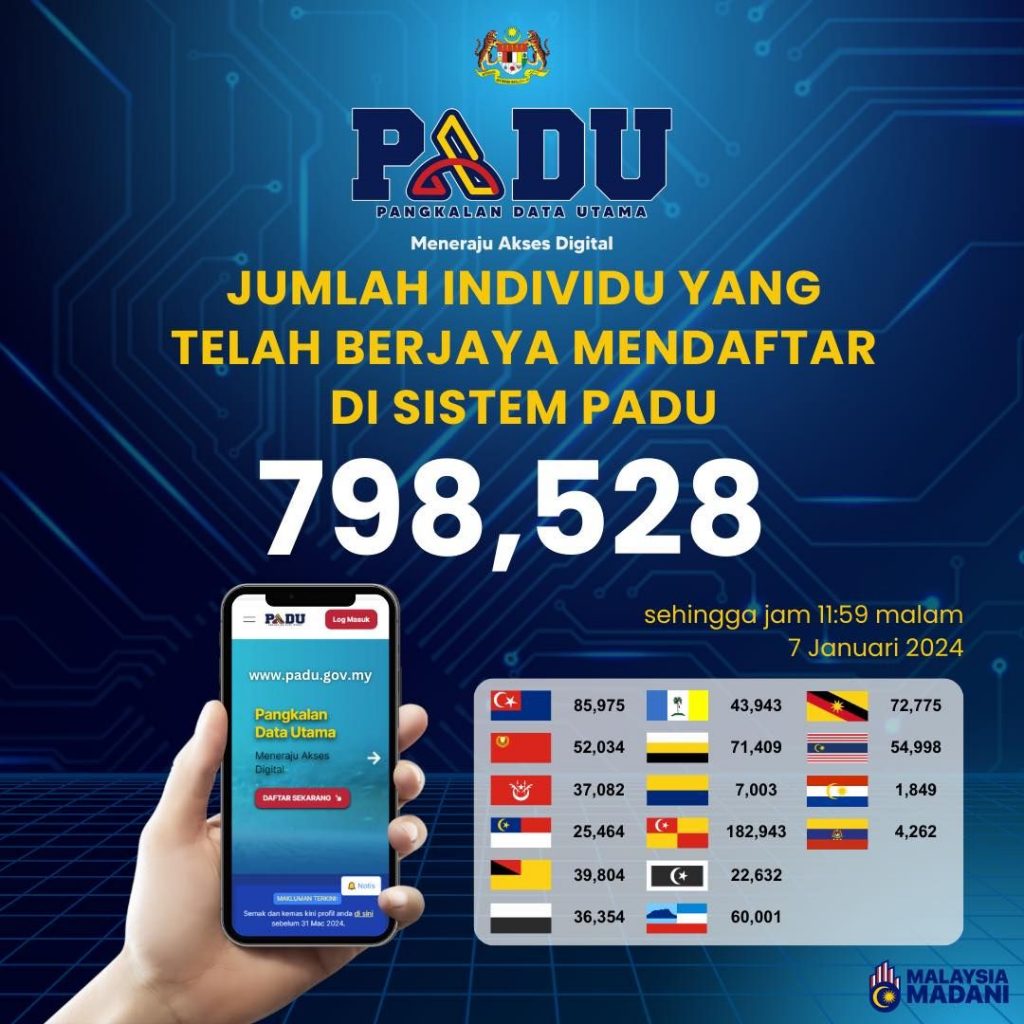It’s nearly a week since PADU, the Central Database Hub, was launched to the Malaysian public. The platform is aimed to be a central data repository which will be used to distribute aid and targeted subsidies including RON95 petrol. In six days, PADU has garnered 798,528 registrations as of 11:59pm on 7th January 2024.
Nearly 800,000 registered for PADU so far

According to the Department of Statistics Malaysia (DOSM), the bulk of PADU registrations came from Selangor with a total of 182,943 users (22.91%) registered. This is followed by Johor with 85,975 registrations (10.77%) and Sarawak with 72,775 registrations (9.11%).
At the current rate, PADU is doing an average of 133,088 registrations per day. It is worth noting that these are merely registration numbers which may not include users who have completed their eKYC process and final submission of their data.
Besides self-registration on the PADU website, the government has also deployed outreach teams (Flying Squad) to assist residents in rural areas without internet and device access.
PADU targets 29 million registration

Communications Minister Fahmi Fadzil has called upon MPs nationwide to encourage mass registration of PADU so that the government’s target of 29 million users can be achieved by 31st March 2024. He shared that Residents Representative Council (MPP) teams will be mobilised to increase registration for PADU.
The Minister said tech-savvy people might have successfully registered but to reach the target, the MPs can also play their role. He added that PADU registration would continue to be online only.
To achieve the target of 29 million users in 90 days, PADU would need to register an average of 322,000 users per day. That’s almost triple the number of daily registrations it is currently recording to date.
There are still concerns about PADU
While most Malaysians understand the need for PADU, there are still concerns about its security and accountability if there’s a data breach. There’s also a mismatch of expectations as the public was told to check and update their information, but turns out that users will have go to through a data entry exercise since most of the sections on PADU are blank.
There are still questions on how the data will be handled and if PADU is truly integrated with other government agencies. If an individual under-declared or over-declared their income, what happens? And how will PADU verify the information and address the conflict of data entry? Some have expressed wary of the need to provide their bank account number and monthly commitments.
Fahmi has said that the government will not misuse PADU data for the elections. As quoted by FMT, he said, “So, it cannot be misused. I believe that even if there were instances of misuse in the past, it won’t happen again.”
“Our campaign methods (for elections) are different and, God willing, we will not misuse it,” he added.
While PADU aims to have the most up-to-date information, users are only allowed to submit their information once when they click on the Hantar Perakuan button. If there’s a need to make further changes, you’ll have to wait until the next window.
PADU was launched 4 days ago. Have you registered, completed eKYC and submitted your information on PADU?
— SoyaCincau (@Soya_Cincau) January 6, 2024
Based on our quick poll conducted on X (formerly known as Twitter) over the weekend, nearly 60% of the respondents have not registered with PADU. Out of the remaining 41.1% who have registered, only about a third of them have completed their PADU data submission.








